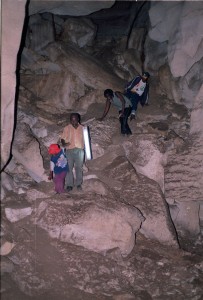The Amboni Caves are one of Tanzania’s less well know tourist attractions, located just 8 km north of Tanga. The most extensive limestone caves in East Africa, formed about 150 million years ago during the Jurassic age, there are altogether ten caves covering an area of 234 km², although only one is accessible for guided tours.
Local people have used the caves as a sacred place for anything up to 600 years, and what appear to be ancient paintings of animal footprints can be seen in some areas, although it is not clear how these were created. The caves certainly have strong significance with the local people, and there are chambers within the caves which are treated as sacred and reserved for worshipping. One of them is called “Mzimu wa Mabavu”, which some believe is the home of a powerful deity who can increase wealth, bring justice, alleviate sickness & sufferings and increase fertility. Bottles with perfumes, oil or blood from sacrificed goats or chicken can be seen at the entrance of the chamber.
Amboni Limited, a company which was then operating sisal plantations in Tanga Region, acquired the area in 1892 and informed the British colonial government about the caves who in turn declared the caves a conservation area in 1922. In 1963, the then government of Tanganyika handed over the caves to the Department of Antiquities.
As well as tourists, the caves attract students for their geography lessons, with examples of stalactites and stalagmites and rocks sculpted into strange shapes from the passage of water. For those with fertile imagination, the guide can point out resemblances of all kinds, including a rock in the shape of a lion at the entrance of the cave, rocks in the shape of a sofa, a ship, a crocodile, an elephant, the US statue of liberty, a statue of mother Mary, and even a map of the continent of Africa !
There are numerous legends associated with the caves, such as a hole which is believed to connect to underground rivers which lead to Mombasa in Kenya. According to one story, in 1914 a European man accompanied by his dog ventured down the hole and disappeared without trace except for the dog which was found dead a few days later in Mombasa. There is also a chamber inside the big cave which was used as a hideout for Osale Otanga and Paulo Hamis, two latter day Robin Hoods who used to steal goods and terrorise foreigners in the region. While the government regarded them as criminals, locals seems to have regarded them as freedom fighters during the struggle for Independence.
However, recently concerns have been growing that the caves are being seriously damaged by blasting in nearby quarries where lime and aggregates are being mined.
Reacting to charges that the government has neglected the historical site, Deputy Minister (Ministry of Natural Resources and Tourism), Mr Ezekiel Maige said he is planning to meet with the Tanga District Commissioner’s Office and the City Council to discuss ways of saving the caves.
He said that the Ministry has initiated a strategy to promote tourism in Tanzania, including the Amboni caves. “The Northern Tourism Circuit has been promoted for years while the North Eastern part which includes the Amboni Caves, the East Usambara mountains and the Saadani National Park has not enjoyed the same publicity,” he said. He noted that the Ministry has already taken steps to improve the area as a tourist attraction by reviewing the area legally and increasing its budget, noting “We have already released over Sh30 million for the purpose. We want the Caves to become one of the identities of Tanga”.

